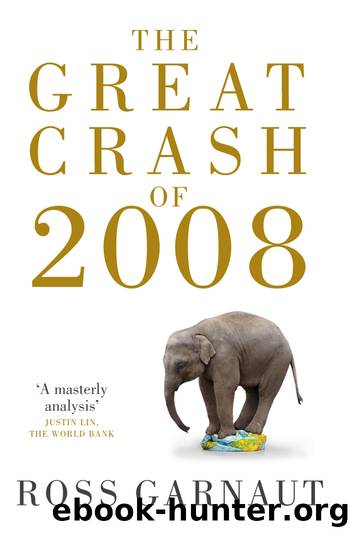The Great Crash of 2008 by David Llewellyn-Smith

Author:David Llewellyn-Smith
Language: eng
Format: epub
ISBN: 9780522860016
Publisher: Melbourne University Publishing
Australian Bailout
In the early days of October 2008, money poured into the big four Australian banks from other financial institutions. But life was becoming increasingly anxious for them as well. One by one they advised the government that they were having difficulty rolling over their foreign debts. Several sought and received meetings with Prime Minister Rudd. The banks told him that, if the government did not guarantee their foreign debts, they would not be able to roll over the debt as it became due. Some was due immediately, so they would have to begin withdrawing credit from Australian borrowers. They would be insolvent sooner rather than later.
To be sure, a sudden and extreme freeze on credit, perhaps enforced by the insolvency of the banks, would end the Australian current account deficit. Spending would fall sharply, and with it the value of imports. The awful reliability of the market process in removing an external deficit once financing dried up was demonstrated in Australia when domestic booms funded by foreign debt ended abruptly with depression in the early 1890s and 1930s. It was demonstrated just as clearly in the Asian Financial Crisis. But the process of adjustment would be enormously disruptive and costly.
The government quickly formed the view that the avoidance of a sudden adjustment through the automatic market process was a worthy object of policy. On 12 October it announced that, for a small fee, it would guarantee the banksâ new wholesale liabilities. This would include the huge rollovers of old foreign debt as it matured. The government also announced a guarantee on all deposits up to A$1 million. All four banks expressed their thanks and relief in a joint meeting with the Prime Minister on 23 October. This became law in November.
There was relatively little public comment on the guarantee of wholesale funding, with The Australianâs experienced economic columnist Henry Thornton being a rare exception. Much more attention was given to the less significant partial guarantee of bank deposits.
Australia was engulfed by a different kind of crisis than that consuming other Anglosphere countries. In the United States, falling asset prices had triggered the collapse of shadow banking. In the United Kingdom, the fallout from that collapse had undermined the larger banks whose assets had been devalued, or which had depended on the continued reliability of the shadow banking mechanisms. The subsequent withdrawal of credit undermined the United Kingdomâs own housing market. In Australia, however, the difficulties were on the liability side of bank balance sheets. Banks had become heavily reliant on foreign borrowing and suddenly they were unable to borrow abroad. The non-banks had had no buyers for their securities for almost a year.
There are no degrees of insolvency. A firm is just as insolvent if it is not able to meet its financial obligations as they fall due because it cannot roll over debt, as it is if the value of the assets in its balance sheet is deeply impaired. The difference is that the problem on the liability
Download
This site does not store any files on its server. We only index and link to content provided by other sites. Please contact the content providers to delete copyright contents if any and email us, we'll remove relevant links or contents immediately.
My Bookstore by Richard Russo & Emily St. John Mandel & Ronald Rice(592)
Official (ISC)2 Guide to the CISSP CBK by Hernandez Steven(462)
Uncommon Grounds: The History of Coffee and How It Transformed Our World by Mark Pendergrast(462)
Judgment of Paris by George M Taber(438)
eCommerce Marketing: How to Get Traffic That BUYS to your Website by Thomas Chloe(410)
How to Build a Billion Dollar App: Discover the Secrets of the Most Successful Entrepreneurs of Our Time by George Berkowski(385)
Information Security Management Handbook, Volume 6 by Tipton Harold F(373)
Hit Lit by James W. Hall(363)
Trade in the Ancient Mediterranean by Terpstra Taco;(344)
Cryptocurrency - A Trader's Handbook: A Complete Guide On How To Trade Bitcoin And Altcoins by Marvin Neuefeind & Marcin Kacperczyk(339)
New Money by Lana Swartz(334)
Manufacturing Consent by Edward S. Herman; Noam Chomsky(317)
THE SILK ROAD ENCYCLOPEDIA by Su-il Jeong;(315)
Nonmarket Strategy in Business Organizations by John A. Parnell(281)
Living with China by Wendy Dobson(280)
101 Things I Learned in Business School by Michael W Preis(277)
The Global Cosmopolitan Mindset by Linda Brimm(268)
Sacred Commerce by Matthew Engelhart(261)
REVENGE OF THE PEQUOTS by KIM ISAAC EISLER(254)
